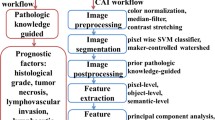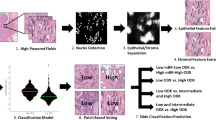Abstract
The aim of the present study was to design a microscopy image analysis (MIA) system for predicting the 5-year survival of patients with laryngeal squamous cell carcinoma, employing histopathology images of lesions, which had been immunohistochemically (IHC) stained for p63 expression. Biopsy materials from 42 patients, with verified laryngeal cancer and follow-up, were selected from the archives of the University Hospital of Patras, Greece. Twenty six patients had survived more than 5 years and 16 less than 5 years after the first diagnosis. Histopathology images were IHC stained for p63 expression. Images were first processed by a segmentation method for isolating the p63-expressed nuclei. Seventy-seven features were evaluated regarding texture, shape, and physical topology of nuclei, p63 staining, and patient-specific data. Those features, the probabilistic neural network classifier, the leave-one-out (LOO), and the bootstrap cross-validation methods, were used to design the MIA-system for assessing the 5-year survival of patients with laryngeal cancer. MIA-system accuracy was about 90 % and 85 %, employing the LOO and the Bootstrap methods, respectively. The image texture of p63-expressed nuclei appeared coarser and contained more edges in the 5-year non-survivor group. These differences were at a statistically significant level (p < 0.05). In conclusion, this study has proposed an MIA-system that may be of assistance to physicians, as a second opinion tool in assessing the 5-year survival of patients with laryngeal cancer, and it has revealed useful information regarding differences in nuclei texture between 5-year survivors and non-survivors.



Similar content being viewed by others
References
Talamini R, Bosetti C, La Vecchia C, Dal Maso L, Levi F, Bidoli E, Negri E, Pasche C, Vaccarella S, Barzan L, Franceschi S (2002) Combined effect of tobacco and alcohol on laryngeal cancer risk: a case-control study. Cancer Causes Control 13(10):957–964
Sant M, Allemani C, Santaquilani M, Knijn A, Marchesi F, Capocaccia R (2009) EUROCARE-4. Survival of cancer patients diagnosed in 1995–1999. Results and commentary. Eur J Cancer 45(6):931–991
Pruneri G, Pignataro L, Manzotti M, Carboni N, Ronchetti D, Neri A, Cesana BM, Viale G (2002) p63 in laryngeal squamous cell carcinoma: evidence for a role of TA-p63 down-regulation in tumorigenesis and lack of prognostic implications of p63 immunoreactivity. Lab Invest 82(10):1327–1334
Dong P, Li X, Zhu Z, Yu Z, Lu G, Sun Z, Wang S (2004) Application of tissue microarray: evaluation of the expression of S-100-positive dendritic cells, tumor suppressor gene p63 and tissue inhibitor of metalloproteinase-1 in laryngeal carcinoma. Acta Otolaryngol 124(10):1204–1207
Takahashi Y, Noguchi T, Takeno S, Kimura Y, Okubo M, Kawahara K (2006) Reduced expression of p63 has prognostic implications for patients with esophageal squamous cell carcinoma. Oncol Rep 15(2):323–328
Borba M, Cernea C, Dias F, Faria P, Bacchi C, Brandao L, Costa A (2010) Expression profile of p63 in 127 patients with laryngeal squamous cell carcinoma. ORL J Otorhinolaryngol Relat Spec 72(6):319–324
Re M, Zizzi A, Ferrante L, Stramazzotti D, Goteri G, Gioacchini FM, Olivieri F, Magliulo G, Rubini C (2014) p63 and Ki-67 immunostainings in laryngeal squamous cell carcinoma are related to survival. Eur Arch Otorhinolaryngol 271(6):1641–1651
Delides A, Panayiotides I, Alegakis A, Kyroudi A, Banis C, Pavlaki A, Helidonis E, Kittas C (2005) Fractal dimension as a prognostic factor for laryngeal carcinoma. Anticancer Res 25(3B):2141–2144
Dobroś W, Gil K, Chłap Z, Olszewski E (1999) The use of nuclear morphometry for the prediction of survival in patients with advanced cancer of the larynx. Eur Arch Otorhinolaryngol 256(5):257–261
Bacauskiene M, Verikas A, Gelzinis A, Valincius D (2009) A feature selection technique for generation of classification committees and its application to categorization of laryngeal images. Pattern Recogn 42(5):645–654
Verikas A, Gelzinis A, Valincius D, Bacauskiene M, Uloza V (2007) Multiple feature sets based categorization of laryngeal images. Comput Methods Programs Biomed 85(3):257–266
Ninos K, Kostopoulos S, Sidiropoulos K, Kalatzis I, Glotsos D, Athanasiadis E, Ravazoula P, Panayiotakis G, Economou G, Cavouras D (2013) Computer-based image analysis system designed to differentiate between low-grade and high-grade laryngeal cancer cases. Anal Quant Cytol Histol 35(5):261–272
Egner JR (2010) AJcc cancer staging manual. JAMA 304(15):1726–1727
Kostopoulos S, Cavouras D, Daskalakis A, Kagadis GC, Kalatzis I, Georgiadis P, Ravazoula P, Nikiforidis G (2008) Cascade pattern recognition structure for improving quantitative assessment of estrogen receptor status in breast tissue carcinomas. Anal Quant Cytol Histol 30(4):218–225
Cheng HD, Sun Y (2000) A hierarchical approach to color image segmentation using homogeneity. IEEE Trans Image Process 9(12):2071–2082
Jain AK (1989) Fundamentals of digital image processing. Prentice-Hall Inc, USA
Haralick RM, Shanmugam K, Dinstein IH (1973) Textural features for image classification. IEEE Trans Sys Man Cyb 3:610–621
Galloway MM (1975) Texture analysis using gray-level run lengths. Comput Graph Image Process 4:172–179
Huang PW, Lai YH (2010) Effective segmentation and classification for HCC biopsy images. Pattern Recogn 43(4):1550–1563
Bandyopadhyay S, Saha S (2013) Unsupervised classification: similarity measures, classical and metaheuristic approaches, and applications. Springer-Verlag, Berlin
Le CT (2003) Introductory biostatistics. Wiley, New York
Specht DF (1990) Probabilistic neural networks. Neural Netw 3:109–118
Kechman V (2001) Support vector machines. Learning and soft computing. MIT, Cambridge, pp 121–184
Theodoridis S, Koutroumbas K (2008) Pattern recognition, 4th edn. Academic Press, USA
Kirk DB, W-mW Hwu (2010) Programming massively parallel processors a hands-on approach. Morgan Kaufmann, Amsterdam
Sidiropoulos KP, Kostopoulos SA, Glotsos DT, Athanasiadis EI, Dimitropoulos ND, Stonham JT, Cavouras DA (2013) Multimodality GPU-based computer-assisted diagnosis of breast cancer using ultrasound and digital mammography images. Int J Comput Assist Radiol Surg 8(4):547–560
Glotsos D, Spyridonos P, Cavouras D, Ravazoula P, Dadioti PA, Nikiforidis G (2004) Automated segmentation of routinely hematoxylin-eosin-stained microscopic images by combining support vector machine clustering and active contour models. Anal Quant Cytol Histol 26(6):331–340
Latson L, Sebek B, Powell KA (2003) Automated Cell Nuclear Segmentation in Color Images of Hematoxylin and Eosin-Stained Breast Biopsy. Anal Quant Cytol Histol 25(6):321–331
Spyridonos P, Cavouras D, Ravazoula P, Nikiforidis G (2002) A computer-based diagnostic and prognostic system for assessing urinary bladder tumour grade and predicting cancer recurrence. Med Inform Internet Med 27(2):111–122
Shamir L, Delaney JD, Orlov N, Eckley DM, Goldberg IG (2010) Pattern recognition software and techniques for biological image analysis. PLoS Comput Biol 6(11):e1000974
Theodoridis S, Pikrakis A, Koutroumbas K, Cavouras D (2010) Introduction to pattern recognition: a matlab approach. Academic Press
Acknowledgments
We would like to thank the Department of Pathology of the University Hospital of Patras for assisting in the peer evaluation of the H&E and p63-stained histologic specimens. We gratefully acknowledge the support of NVIDIA Corporation for the donation of the Tesla K20 GPU used for this research.
Author information
Authors and Affiliations
Corresponding author
Rights and permissions
About this article
Cite this article
Ninos, K., Kostopoulos, S., Kalatzis, I. et al. Microscopy image analysis of p63 immunohistochemically stained laryngeal cancer lesions for predicting patient 5-year survival. Eur Arch Otorhinolaryngol 273, 159–168 (2016). https://doi.org/10.1007/s00405-015-3747-x
Received:
Accepted:
Published:
Issue Date:
DOI: https://doi.org/10.1007/s00405-015-3747-x




